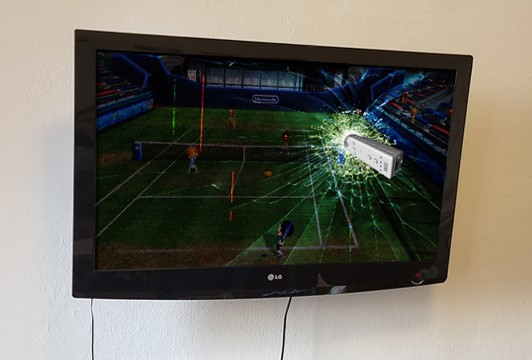

Surely the living room is free from maths?
Well, take a comfy seat and let the numeracy tour begin...
There are a number of movies out there that have a mathematical theme. These would include titles like 'The Imitation Game', 'A Beautiful Mind', 'Proof' and 'Good Will Hunting'.
So, if I ignore these films and watch something else, there will be no maths.
How about the numeracy involved in planning a movie night, or just trying to fit one into a set schedule?
All movies (whether streamed or in a box), include details regarding the movie's length. The catch is, these are quite often written in minutes rather than hours, so a little maths is required to work out whether you have the time to watch it.

A similar timing issue can be found when watching a tv series, how many whole episodes can you fit in to your schedule?
Don't forget, these scenarios will also involve estimating time needed for bathroom or kitchen breaks, as well as switching between the episodes. The more people watching, the more frequent the breaks will be, the longer the total pause time.
It's quite easy to forget about the simplest applications of numeracy - such as the ability to know one's own age and whether a film certification means a movie is suitable viewing or not.
Most living rooms will include some form of art on display.
What's art got to do with maths?
As stated in the above section, some mathematical skills are easy to overlook, perhaps due to their simplicity, or maybe it's just that we're not looking for them.
Identifying shapes is a very basic level mathematical skill that most people learn at a very early age. A knowledge of shapes forms the basis of most art forms.
Not knowing what art there might be in your living room, we shall look at some examples.
To produce a realistic painting, the artist needs to have an understanding of proportions and perspective.

Anything produced to be visibly appealing has been designed using the Golden Ratio.
Most vases or lamp bases incorporate symmetry.
Magnification and focus are of importance to professional photographers.
Some art materials require knowledge of ratios to mix correctly.
Even a coffee table or armchair needed maths in their design to ensure they are a suitable size and height for most people to use comfortably.
Although you don't need these skills to view/use/enjoy such pieces, our brain would recognise if the maths was inaccurate, resulting in things looking 'wrong'.
Some artists actually use this knowledge to produce purposeful illusions.

For computer gaming, please check the Maths in the Study page.
There are a whole array of different types of games available for all ages. These include classic board games, card games, tabletop gaming and basic pen and paper games.

Most games involve the winner having the highest or lowest score, some even involve multiple point calculations throughout the game.
Any player in a game involving dice or playing cards, would benefit from an understanding of probabilities.
Tabletop gaming can also involve matrices, statistics and measuring.
Some games include currency as part of the gameplay, with some also including interest rates, mortgages and/or pensions.
This means that games are often a good way to practice basic numeracy skills as well as having fun.
With all this in mind, have a look at what games you have and then try to work out which you think involves the most maths, why?
Hopefully, you are starting to realise that we use basic maths skills without even thinking about it on a daily basis.
Who doesn't know the best spot to watch TV in their living room? You could say this was found through trial and error, but we can all make a guess which involves considering the angle of viewing and the distance from the screen.
No-one would even consider being off to a far side of the screen as the best viewing location.
The angle of viewing, the optimum distance and the screen resolution should play a role in buying a TV too. You need an understanding of the layout of your living room, the position of the TV and how different screen types affect these factors.
We can all agree on the idea of a TV being too small, but is it also possible to be too large?
If you are fortunate to have an external sound system, whether for a stereo or TV, where should you place the speakers? Again, trial and error could be a time consuming approach to this problem. An easier approach is to use a basic knowledge of the physics of sound.
Most external sound systems come with instructions explaining the best positioning for them, although this is rarely possible dependent on the layout of the architecture and furniture, so some understanding is required to best counter these issues.
How would you consider arranging a surround system, consisting of four speakers and a sub-woofer, in your living room? Then, consider why you have chosen those positions.
The last part of this section is looking at the new addition to some homes of AR (Augmented Reality) and VR (Virtual Reality) equipment.

To set up a Kinect, Wii, or Move involves working out the best location for the sensor bars. This follows similar principles to the sound system set-up. You wouldn't automatically consider the floor or the ceiling as good mounting points, why?
To use any such equipment requires you to have a safe space in which you will not accidentally injure yourself or damage anything. We are all capable of estimating how much space we need to clear to achieve this.
As a side note to this, we are all able to judge when we are likely to hit something, or be hit and automatically attempt to avoid the collision. This means that we are doing maths and physics calculations without conscious thought to avoid bodily injury.
All forms of logistics or organisation incorporate some form of numeracy. This includes organising space in the home, working out a suitable lay-out of seating within a room in respect to focal points such as a television or a table.
One mistake often made, is in the consideration of how to get furniture into a room. Sofas and beds are the main culprits for problems getting them into the house and then the correct room.
If you have a sofa, think about how it got to where it is.

If you host a movie night with friends for example, you will need to work out the best seating arrangement you can give in the space and with the furniture available to you.
Catering for these events, even if it's just drinks and popcorn requires the use of basic numeracy to make sure you have enough refreshments for everyone attending, but not so much you end up having to throw any away.
Try to figure out the maximum number of people you could have in your living room (with and without social distancing) whilst having them all be able to see the television screen clearly. Don't forget they will also need safe places to put their drinks down to avoid spillages.
Have we missed something?
If yes, then please let us know by e-mailing nar25@aber.ac.uk.